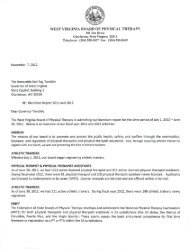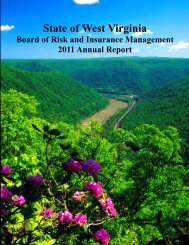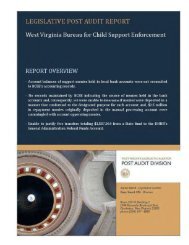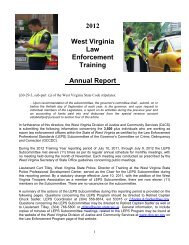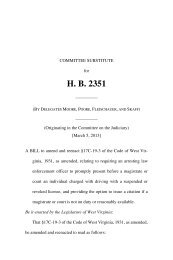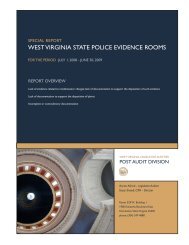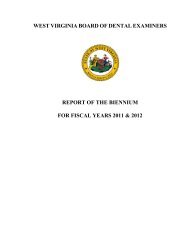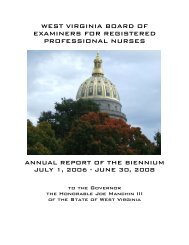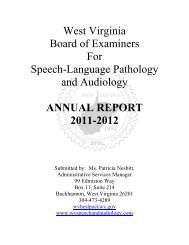2011 AnnuAl RepoRt - West Virginia Department of Commerce
2011 AnnuAl RepoRt - West Virginia Department of Commerce
2011 AnnuAl RepoRt - West Virginia Department of Commerce
You also want an ePaper? Increase the reach of your titles
YUMPU automatically turns print PDFs into web optimized ePapers that Google loves.
GENERAL GEOSCIENCE PROGRAMGeologic MappingGeologic Mapping at WVGES consists <strong>of</strong> two majorcomponents: the direct acquisition <strong>of</strong> new geologicalinformation through field reconnaissance and the digitalconversion <strong>of</strong> existing geological information from hard copy(paper, mylar, etc.)• Acquisition <strong>of</strong> new geological data is carried out underthe auspices <strong>of</strong> the STATEMAP program funded jointly bythe United States Geological Survey (USGS) and WVGES.In October 2010, the STATEMAP Advisory Committee,composed <strong>of</strong> individuals from industry, governmentand academia, met to evaluate two alternative mappingareas within <strong>West</strong> <strong>Virginia</strong> for the upcoming <strong>2011</strong> fieldseason. During the summer and fall <strong>of</strong> 2010, field work wasconducted on a single 7.5 minute topographic quadranglein eastern <strong>West</strong> <strong>Virginia</strong> (Greenland Gap). Published asWVGES Open File Report, this data is currently available asa paper map; digital conversion <strong>of</strong> the map is complete andin the process <strong>of</strong> review. Field work on a new STATEMAPproject (Clover Lick) began in June <strong>2011</strong>.• In August 2009, WVGES submitted a successful proposalto the National Park Service to map the geology <strong>of</strong>three Park units within the state <strong>of</strong> <strong>West</strong> <strong>Virginia</strong>. Overa three-year period, a consortium <strong>of</strong> geologists fromWVGES, <strong>West</strong> <strong>Virginia</strong> University, and Concord Universitywill map the bedrock and surficial geology <strong>of</strong> theFayetteville, Thurmond, Beckwith, Winona, Danese, Prince,Meadow Creek, Hinton, Meadow Bridge, Talcott, Ansted,Summersville Dam, Flat Top and Pipestem quadrangles.These map areas cover park lands within the Gauley RiverNational Recreation Area, the New River Gorge NationalRiver Area and the Bluestone National Scenic River Area.Final versions <strong>of</strong> the Ansted and Summersville Damquadrangle maps were submitted to the Park Servicein October 2010. Field work on the second year <strong>of</strong> thisproject began in the spring <strong>of</strong> <strong>2011</strong> with WVGES mappingteams working on the Fayetteville, Thurmond, Winona andDanese quads.• Digital conversion <strong>of</strong> existing and future map informationis a high priority at WVGES. During FY <strong>2011</strong>, digital maps <strong>of</strong>the Ansted, Summersville Dam, Mannington, Paddy Knoband Mustoe (WV portions), Bethany, Tiltonsville, Ripley,Sissonville, Big Chimney, Louisa (WV portion), Fallsburg (WVportion), and Bramwell quads were completed.Mine Pool Atlas ProjectThis two-year project, funded by the USEPA through theDivision <strong>of</strong> Water and Waste Management (DWWM) <strong>of</strong> the<strong>Department</strong> <strong>of</strong> Environmental Protection (WVDEP), continuesto evaluate abandoned coal mines as a source <strong>of</strong> storedground water capable <strong>of</strong> providing large volumes <strong>of</strong> waterfor various private, public and industrial uses in <strong>West</strong> <strong>Virginia</strong>.To better understand the potential <strong>of</strong> this water source fordevelopment, WVGES is building a dynamic, interactive GISto portray mine pools, the structure contour <strong>of</strong> the base <strong>of</strong>each coal seam, and an isopach <strong>of</strong> each coal seam. GIS toolsare being used to estimate mine pool volumes from availableWVGES Coal Bed Mapping Program (CBMP) mining and coalseam data. Available existing mine pool water quality datawill be collected and linked to the GIS in the final phase <strong>of</strong> theproject.
The WVGES continues to regularly update an InteractiveMapping Service (IMS), accessible via its website, for theMarcellus Shale. This service gives users the opportunity todirectly search for information concerning characteristics <strong>of</strong> theMarcellus formation (e.g., presence and depth) and informationfor specific completed and permitted wells. The Marcelluswebpage also contains downloadable files <strong>of</strong> permitted andcompleted wells and cancelled permits. GIS shapefiles areavailable for several important geologic features and units, andlinks to several published resources are provided.Through the end <strong>of</strong> fiscal year <strong>2011</strong> (i.e., June <strong>2011</strong>), a total <strong>of</strong>1,408 Marcellus Shale well completions had been processed byWVGES over the past nine years; there are 1,372 active permitsto-drillinto the Marcellus Shale. The most active counties withcompleted wells at this time include Kanawha, Logan, Ritchie,Jackson and Lincoln (see map), mostly with vertical wells.New completion practices include developing horizontalcompletions in the northern part <strong>of</strong> the state, in the classicMarcellus Fairway.WVGES staff members have responded to hundreds <strong>of</strong>inquiries about the Marcellus from private citizens, government<strong>of</strong>ficials and industry pr<strong>of</strong>essionals interested in a wide range<strong>of</strong> issues, including property leases, environmental impactsand geologic characteristics <strong>of</strong> the formation. In addition toroutine responses, WVGES geologists have made a number <strong>of</strong>presentations to various groups interested in this subject.Carbon SequestrationCarbon sequestration is receiving considerable attention as ameans for reducing the quantity <strong>of</strong> carbon dioxide releasedinto the atmosphere. The process <strong>of</strong> sequestration involvesinjecting carbon dioxide deep into underground reservoirswhere it can be stored indefinitely.Carbon dioxide is <strong>of</strong> particular interest since it is a natural byproductfrom the combustion <strong>of</strong> fossil fuels, especially coal,an important economic resource for <strong>West</strong> <strong>Virginia</strong>. Carbondioxide has been shown to be a significant greenhouse gasthat contributes to the entrapment <strong>of</strong> heat from the sun withinthe earth’s atmosphere. By capturing and sequestering carbondioxide in deep underground reservoirs, coal can effectively beutilized as a carbon-neutral source <strong>of</strong> fuel.In many ways, the sequestration <strong>of</strong> greenhouse gases is similarto the production <strong>of</strong> oil and natural gas. Instead <strong>of</strong> beingwithdrawn from subsurface reservoir rocks, sequestrationinvolves the charging <strong>of</strong> underground reservoirs with carbondioxide. Both processes are dependent on low-permeabilityrock formations, known as seals, to cap the reservoirs andcontain the gas or oil within them.WVGES is an active participant in the Midwest Regional CarbonSequestration Partnership (MRCSP), a group <strong>of</strong> industrialand government institutions dedicated to the selection andcharacterization <strong>of</strong> potential large-scale sequestration sites.The MRCSP is one <strong>of</strong> seven regional partnerships establishedby the U.S. <strong>Department</strong> <strong>of</strong> Energy.The focus <strong>of</strong> the MRCSP Phase I research was identification <strong>of</strong>regional sources <strong>of</strong> carbon dioxide and storage opportunities.Phase II concentrated on further characterization <strong>of</strong> potentialstorage formations and small-scale field testing. TheWVGES contributed significantly to several Phase II finalcharacterization reports. Phase III work involves furtherreservoir characterization and a large-scale geologic field test.The WVGES will build on the characterization <strong>of</strong> prospectivereservoirs and seals in Phase III by further defining thestructural and stratigraphic characteristics <strong>of</strong> key sequestrationtarget formations. WVGES also contributed to a studyconducted by the <strong>West</strong> <strong>Virginia</strong> Division <strong>of</strong> Energy whichstudied the sequestration potential <strong>of</strong> several deep salineaquifers throughout the state, including the Oriskany, Newburgand Tuscarora Sandstones.
OFFICE OF Gis COORDINATIONThe <strong>of</strong>fice made significant headway in a number <strong>of</strong> critical areas,including data sharing between agencies and providing technicalassistance to state, local agencies and the public, while fosteringthe efficient and effective use <strong>of</strong> the state’s geospatial capabilities.Executive Order 10-10 issued in January <strong>2011</strong> formally establishedthe State Office <strong>of</strong> GIS Coordination within the <strong>West</strong> <strong>Virginia</strong>Geological and Economic Survey and better defines thecoordinator’s duties and responsibilities. An updated StatewideGIS Strategic Plan approved in January <strong>2011</strong> articulates a strategicvision for the development and use <strong>of</strong> geospatial technology withinstate government and sharing <strong>of</strong> information with federal, local andprivate entities for the benefit <strong>of</strong> <strong>West</strong> <strong>Virginia</strong>ns.Created in collaboration with the <strong>West</strong> <strong>Virginia</strong> GIS Technical Center,Rahall Transportation Institute, <strong>West</strong> <strong>Virginia</strong> State Tax <strong>Department</strong>Property Tax Division, county assessors and 911 directors, CadastralGIS workshops were given at locations throughout <strong>West</strong> <strong>Virginia</strong>.These workshops are designed to inform, train and advise countyand local government <strong>of</strong>ficials that have GIS programs in the latesttechnology and at the same time to educate those <strong>of</strong>ficials thathave not embraced GIS technology in their own organizations. TheOGC began development <strong>of</strong> a Statewide Cadastral Layer BusinessPlan in cooperation with Rahall Transportation Institute.The coordinator continues to provide general administrativeoversight <strong>of</strong> the Mineral Lands Mapping Program; new proceduressuggested by the coordinator produced significant results.The <strong>of</strong>fice provided technical assistance and advice to the<strong>Department</strong> <strong>of</strong> Environmental Protection, the Water DevelopmentAuthority (WDA), the National Guard, the <strong>West</strong> <strong>Virginia</strong> IntelligenceFusion Center, the Division <strong>of</strong> Homeland Security and EmergencyManagement’s Hazard Mitigation section, and other state andlocal agencies in their search <strong>of</strong> GIS contract services and/or GISapplication development.The coordinator attended sessions and presentations at the annualand mid-year National States Geographic Information Council(NSGIC) conferences in Cleveland, Ohio, and Annapolis, Md. Thecoordinator participated in sessions <strong>of</strong> the WVGIS Policy Council,the <strong>West</strong> <strong>Virginia</strong> Information Technology Council, the GIS SteeringCommittee, E911 Council, Green Infrastructure Committee and theStatewide Addressing and Mapping Board.Broadband Mapping ProjectThe Office <strong>of</strong> GIS Coordination continues to have oversightover a National Telecommunications and Informationand Administration Broadband Mapping Grant totaling4.7 million dollars. The program, funded by the AmericanRecovery and Reinvestment Act, aims to increase broadbandaccess and adoption through better data collection andbroadband planning. Besides being displayed in NTIA’snational broadband map, data gathered under this programis displayed on a state interactive mapping application.This tool informs <strong>of</strong> policymakers’ planning and build-upefforts and provides <strong>West</strong> <strong>Virginia</strong> citizens with improvedinformation on the broadband Internet services availableto them. The Broadband Mapping Program has three majorcomponents:Technical Assistance Project: In partnership with theAppalachian Transportation Institute, the <strong>West</strong> <strong>Virginia</strong> GISTechnical Center, and the 11 Regional Planning Councils, the<strong>West</strong> <strong>Virginia</strong> Geological and Economic Survey Office <strong>of</strong> GISCoordination undertakes community-level research to assessand investigate areas with low broadband adoption ratesand then develops a statewide plan to improve broadbandadoption. Partnering organizations will also provide directtechnical assistance to the Broadband Deployment Council,and to Regional Planning Teams created under the programpresented below, as well as to individual municipalities thatmay, for example, require a cost modeling assessment inorder to apply for a grant or loan.Local Regional Technology Planning Teams Project:This project supports local planning groups in each <strong>of</strong> the11 <strong>West</strong> <strong>Virginia</strong> Planning and Development regions. Eachplanning and development region will host a regionalcouncil that will work with stakeholders to develop regionalbroadband awareness and adoption plans. As part <strong>of</strong> thiswork, each regional council will administer and analyze asurvey designed to assess the opportunities for broadbandbasedeconomic development.Mapping Project: This project was originally fundedfor broadband planning activities and two years <strong>of</strong> datacollection. In September <strong>of</strong> 2010, this project was amendedto extend data collection activities for an additional threeyears and to identify and implement best practices.<strong>West</strong> <strong>Virginia</strong> Broadband Mapping Program: www.wvbmp.org
APPLIED COAL RESOURCESCoal-bed Mapping Project (CBMP)Survey geologists continue to progress on the StatewideGIS-based inventory <strong>of</strong> <strong>West</strong> <strong>Virginia</strong>’s coal resources. Theseproducts are regularly updated and can be viewed on theSurvey’s website. This data is provided to the <strong>West</strong> <strong>Virginia</strong><strong>Department</strong> <strong>of</strong> Revenue where the information is used togenerate state tax revenues for the counties. Mapping hasstarted in areas that are extremely difficult to correlate due tothe geographic limited extent <strong>of</strong> coal beds and isolation <strong>of</strong> theregion from the main coal field. Although key personnel haveleft state government for the private sector due to an increasein high-paying mineral industries jobs, current goals still shouldbe met during the coming fiscal year.All stratigraphic data has been migrated into a new Oracledatabase on a provisional basis. Beta testing will beginthis fall. We continue to add new data to our stratigraphicdatabase through cooperation with industry contacts andother governmental agencies. These additions allow continualrefinement <strong>of</strong> the various map products. All available data fileshave been scanned into a PDF format. We are exploring options<strong>of</strong> serving permissible data through the Survey’s website.Elkins Mapping ProjectSurvey coal geologists continue mapping five 7.5’ quadranglesnear Elkins: Junior, Elkins, Beverly <strong>West</strong>, Beverly East and theSinks <strong>of</strong> Gandy. More than 1,600 geologic data points havebeen collected, geologic contacts have been drawn and themaps are being reviewed by Survey geologists. This project isproducing 1:24,000 scale geologic maps in digital format for apart <strong>of</strong> the state that has received little attention since the early1900s. Completed geologic maps will enhance ongoing effortsin nearby areas to update the state’s geology. This projectexpanded into the Bowden quadrangle in May <strong>2011</strong>.Coal QualityThe Coal Program maintains a robust and growing computerizeddatabase <strong>of</strong> the chemical and physical characteristics <strong>of</strong> <strong>West</strong><strong>Virginia</strong> coals. This database has been effective in aidingpotential customers to identify specific <strong>West</strong> <strong>Virginia</strong> coals thatmeet their needs for power generation and to serve as chemicalfeedstock or as a source <strong>of</strong> coal-to-liquid applications. Duringthe year we initiated a cooperative agreement with the KentuckyGeological Survey to analyze coal samples, enabling the Surveyto continue collecting new coal samples from areas <strong>of</strong> the statethat are currently poorly represented in the databases.National Coal Resources Data System (NCRDS)This long-running cooperative research initiative between theU.S. Geological Survey and WVGES Coal Program has enabledboth partners to maintain and grow their respective coaldatabases. In addition to facilitating important research onvarious aspects <strong>of</strong> coal, coal mining and resource analyses, thecooperative has resulted in the collection <strong>of</strong> valuable data on theoccurrence, distribution and quantities <strong>of</strong> various trace elementsfound in <strong>West</strong> <strong>Virginia</strong>’s coal measures. This program has beencontinued for an additional year.Underground Mine Mapping ProjectCoal Program geologists, in conjunction with <strong>West</strong> <strong>Virginia</strong>’sOffice <strong>of</strong> Miners Health, Safety and Training (OMHST) continueto expand the large collection <strong>of</strong> coal mine maps by obtainingpreviously unavailable historic maps from various repositories.The footprints <strong>of</strong> newly obtained maps are digitized and addedto the Survey’s coal bed GIS. Ancillary information is enteredinto WVGES’ stratigraphic database for use in the statewide coalbed GIS. Footprints <strong>of</strong> active mine areas are updated annually.Additional mine maps received from other state agencies andindustries are added to the database.Mine Information Database SystemThe Mine Information Database System (MIDS) is updated asnew mine maps become available. MIDS contains records <strong>of</strong>every mine map available at the WVGES and is comprised <strong>of</strong>more than 44,000 documents depicting more than 71,000 mines.Submissions and comments from online users are requested tomake the system more complete and user-friendly.





